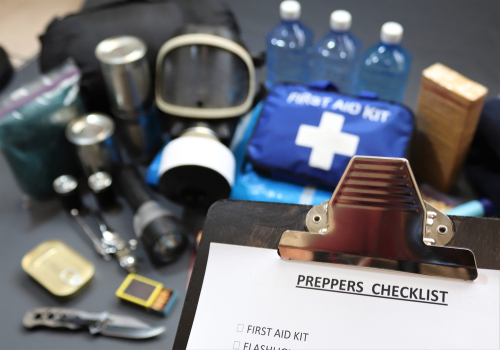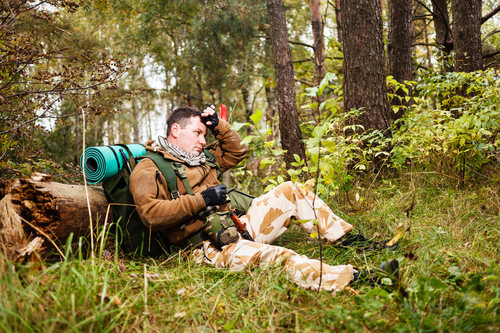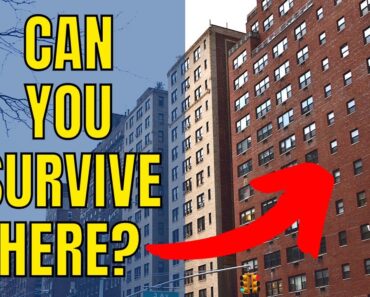If the proverbial brown stuff hits the fan and your area is affected by the event, you should be prepared to make it on your own.
No matter what the event might be or who caused it, if it becomes a threat to the physical integrity and overall, the well-being of your family, you will have to act.
In most cases, you will be forced to choose between hunkering down or bugging out. Regardless of what you planned for, you will need to gather some critical information before picking a proper course of action.
Every conscious or subconscious action you make can affect
your safety and put you in danger. Every sound, every word, and even a simple
gesture you make can trigger a certain type of response. You have to make sure
you are ready for it.
You may choose to bug in, or you may head for the woods. However,
every single action you make influences and solicits a response. This is why
having a certain type of information is crucial to your survival.
The following strategies can be applied regardless if you bug in or bug out:
Spend time to know the people around you
This is a topic that is not given the appropriate coverage
and importance in the survival literature available out there. It is one of the
most important things you should be aware of. Learning as much as possible
about your neighbors and overall community will provide you with the proper
information you can act upon when SHTF.
Going to social gatherings or even observing some from a
safe distance will let you discover important things about your neighbors. Some
of them may have an anti-gun agenda, some of them may be preppers, while some
of them may be underachievers, and so on.
Also, doing a little research about the crime rate in your
area and reading reports that involved social upheaval during certain events
will help you discover how the members of your community are “programmed” to
act (protesting, looting, rioting, etc.).
And last but not least, I encourage you to interact with
your neighbors whenever you have the chance. Do so during your daily activity
or during enjoyable activities such as barbeques and other gatherings.
Before SHTF, you should pay attention to all the surrounding
elements that can cause problems much worse than the event itself. I can’t
stress this enough! No other element is more unpredictable than human nature.
Know your position
In every survival scenario that involves either bugging in or bugging out, there are two things to consider regarding your position: your geographical position and your social position. Learning about your living area (geographical position) is a must, whatever you plan on doing when it hits the fan.
- It will provide you with valuable information, and you will find an answer to questions such as:
- Is your area listed on an evacuation route? If so, you have to think about the masses of people going through your backyard in search of safety.
- Is your home surrounded by thick vegetation? (this becomes a problem during a wildfire)
- Is your home located in a flood zone?
- Is there more than one route you can use to bug out or to resupply?
- Do you have a backup shelter in your area? A pre-made bug out location is ideal, but if none is available, you can make good use of abandoned buildings, state parks, or any other type of location that offers good living (call it camping if you will) conditions.
- Do you have any options for gathering supplies if your own stock runs dry? This may require activities such as hunting, foraging, and even scavenging.
- Do you have any water sources in the vicinity of your home? Did you map them?
- Are you able to defend your property on your own if it comes to that? Do you need help from trust-worthy neighbors?
- Are you just as exposed as the rest of your neighbors? Or do you live in a more secluded area?
These questions may not be obvious at first, but you should
have an answer for them. The list can be much longer, and it all depends on
your geographical position as each has its distinctive properties.
Now when it comes to your social position, things are a
little more complicated. It mostly depends on how you are seen by the
surrounding eyes. If you are a respectable, friendly, and law-abiding citizen,
it would be much easier to get help from your neighbors in case you needed. At
least in theory.
On the other hand, if you are invisible and most of your neighbors have no idea what type of person you are, most of them will not come to your aid. This may be good if you want to keep a low profile, but not so good if you rely on others to survive an SHTF event.
Now let’s say you are the anxious type of person. In this
case, the less desirable elements of society within your community may very
well target you when things go south. If you are the sanguine type, an
optimistic and way too social individual, you may very well become a victim of
circumstances when SHTF.
As a member of a community (may it be large or small) you
should really analyze your position within that community, especially if you
decide to bug in. If there’s a grudge between you and your neighbors, what
makes you think they won’t be looking to settle scores when the law no longer
applies?
Know your options
This may sound generic at first, but there are many mistakes most preppers make, especially those that are new to all of this. I’ve seen many cases of preppers that reached a certain level of comfort or tranquility by assuming they’ve got everything covered.
Some manage to equip a pantry fully and they believe the
work is done. They get a certain feeling of accomplishment that affects basic
common sense. They fail to rotate their supplies, and they don’t even think
about what could be carried if they are forced to evacuate. Even more, they
don’t experiment with the foods they have and so on.
There’s a certain feeling of false confidence that many of
us develop, and we stop believing there’s room for more. We are almost certain
there’s nothing we can improve anymore, and usually, our prepping stops. We
believe we have everything figured out, when in fact, there are more things we
should be doing. Emergency preparedness is a constant activity and I believe it
never stops. There are always things we missed or we haven’t thought about.
Emergency preparedness requires a certain mindset that it’s
hard to achieve, and it doesn’t matter if you plan to bug in or bug out. You
should always make sure you are prepared to handle the unexpected and turn
things in your favor. Events will always change rapidly and you can’t predict
the random factor. What you can do is have a backup, but for that to work, you
need planning and organization.
I’ve written before that every emergency preparedness
project should start with establishing what you need to prepare for and plan
for other options (backups) if things don’t go as you initially planned.
Know your paths
This topic covers the safe routes available in your area,
and once again, there are many approaches to it. A safe route is a route that
helps you reach your destination point without any issues and it doesn’t matter
if you bug in or bug out, the rules apply to both scenarios.
Bugging in safe paths:
- One or more routes to help you reach your loved ones when it hits the fan. Here you may have routes to get your kids from school or perhaps to get your spouse from work or other location that may not be safe when SHTF.
- One or more routes to meeting points so you can regroup regardless if someone is at work or doing various errands. If something happens and you are not at home, you should have pre-established meeting points that every family member should be fully aware of.
- One or more routes to help you reach your home without having to overcome roadblocks, stopping points, or going through iconic landmarks that can be prone to looting or rioting.
- You also need a few routes mapped that should be used for scavenging if you will be forced to do so
- One or more routes to evacuate if you are forced to leave the safety of your home
Bugging out safe paths:
- One or more routes to meeting points (some other
people may be expected to join your party) - One or more routes to observation points
- More than one alternative route to your bug out
location - In case you have caching points, you need safe
routes to reach your caches - In case you will have to hunt or forage you need
safe, secluded routes to reach those grounds - One or more routes to areas used for resupplying
or to reach friendly parties (relatives, first aid, friends, etc.)
Learn to acknowledge and accept your limits
This aspect is often overlooked, and I believe it’s often due to our “can do” attitude and overall, our country’s history that makes us a proud nation. From a young age, we are programmed to believe that everything can be achieved if we work hard for it. However, an emergency situation requires acknowledging and accepting your limitation and never putting them to the test (unless it’s the last resort).
I believe that you need to go that extra mile only if your
life depends on it. There is no point in putting yourself at risk for little to
no gain, and you need to be cautious about your actions.
As a quick example, if you decide to hunker down after
establishing that it’s your only option to survive the event you’ve been
prepping for, you should plan and prepare for said event based on your
possibilities. You need to make sure you can ride it out and have the proper amount
of supplies to do so.
However, even if you have enough supplies, you should also
have the means to survive after the danger has passed. You need to know about
your physical limits as well, and if you have a disability, going out for a
scavenging run might not be an option for you.
On the other hand, if you need to fend off looters and you
are the only one who can do so, a direct, full-force attack will be in vain.
You need to buy yourself time and you should concentrate your efforts on
deceiving the trespassers by making your house look inhospitable, make it look
like it was already looted or checked by the authorities. Try to fortify your
home and establish a perimeter that can slow or incapacitate any trespasser.
Any off-putting elements that you can think of and implement
will create a critical advantage and provide you enough time to confront
multiple aggressors.
If it comes to bugging out, it is equally important to know
your limits, and you should start by assessing your physical condition and establishing
if you are fit to make the journey. You may have the latest gear and a state of
the art bug out bag, but if you can’t carry it over long distances, it becomes
just an expensive accessory.
Sure, you may use your vehicle to make most of the journey,
if not the entire journey, but what happens if it breaks down? Do you have the
proper knowledge to figure out what’s wrong and if it can be fixed or not?
Prioritization plays an important role when bugging out, and
for example, you need to be certain what supplies you can leave behind, if you
hide them or not, depending on the available time, and what you can carry and
for how long.
Every scenario follows the same rule, and you need to know what you are cable of. You may have enough ammo and firepower do decimate the entire deer population in a certain area, but that won’t help if you never hunted such creatures before. Game may be available, but you need to know how to track, stalk, and kill it. I’m not even going to get into details about butchering and other mandatory steps following a successful kill.
Even activities that may seem simple at first require a
piece of certain knowledge and expertise. Cutting down trees and transporting
the logs may look simple, but I assure you it is not as you’ve seen in the
movies.
Besides knowing how to bring down a tree, you also need to
have the proper body strength to do the job. How about carrying the log back to
camp? Do you know how to improvise a transportation method? How about getting
help from your family without injuring them?
Knowing your limits will not only help you get things done,
but it also provides you with a great advantage. It will help you take care of
yourself, of your physical integrity, but also your mental health. These two
factors are crucial if you are aiming for long-term survival.
Concluding
As you’ve seen in this article, no matter if you choose to
bug in or bug out, there are certain things you need to be prepared for. These
pay an important role in your survival even if some may not be important at
first.
There isn’t a perfect recipe for success when it comes to emergency preparedness, and you need to make your own plan, test it, and learn from your mistakes and limitation.































